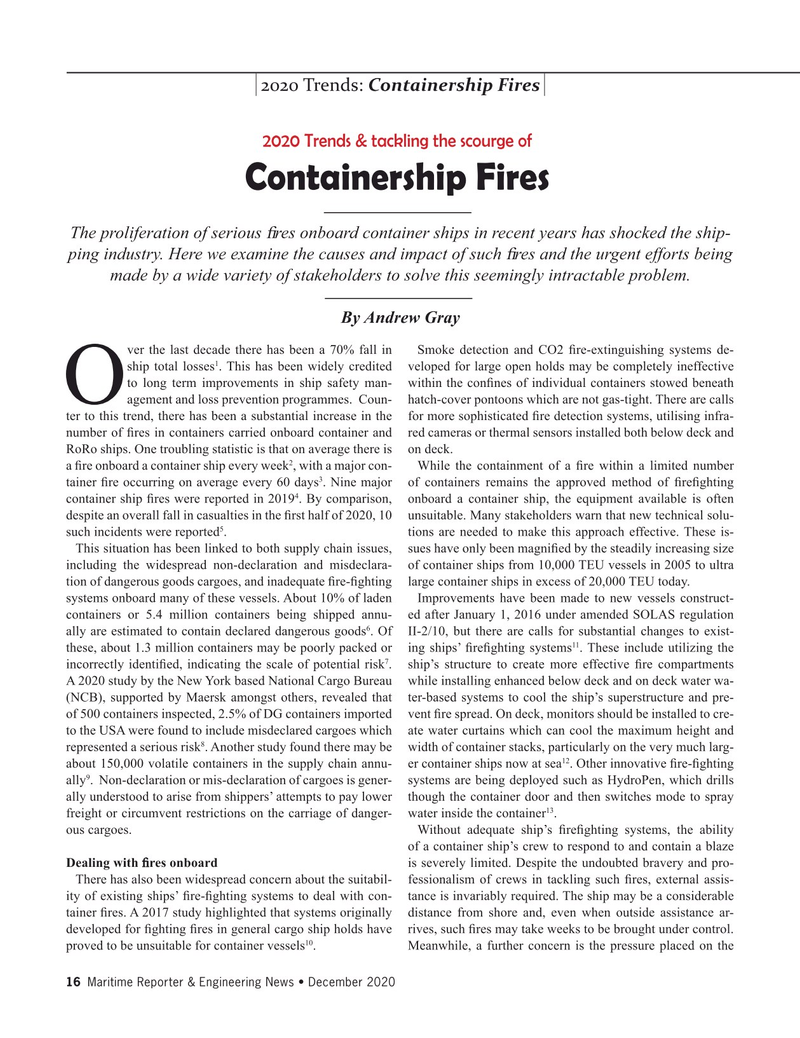
Page 16: of Maritime Reporter Magazine (December 2020)
Great Ships of 2020
Read this page in Pdf, Flash or Html5 edition of December 2020 Maritime Reporter Magazine
2020 Trends: Containership Fires 2020 Trends & tackling the scourge of
Containership Fires
The proliferation of serious ? res onboard container ships in recent years has shocked the ship- ping industry. Here we examine the causes and impact of such ? res and the urgent efforts being made by a wide variety of stakeholders to solve this seemingly intractable problem.
By Andrew Gray ver the last decade there has been a 70% fall in Smoke detection and CO2 ? re-extinguishing systems de- 1 ship total losses . This has been widely credited veloped for large open holds may be completely ineffective to long term improvements in ship safety man- within the con? nes of individual containers stowed beneath
O agement and loss prevention programmes. Coun- hatch-cover pontoons which are not gas-tight. There are calls ter to this trend, there has been a substantial increase in the for more sophisticated ? re detection systems, utilising infra- number of ? res in containers carried onboard container and red cameras or thermal sensors installed both below deck and
RoRo ships. One troubling statistic is that on average there is on deck.
2 a ? re onboard a container ship every week , with a major con- While the containment of a ? re within a limited number 3 tainer ? re occurring on average every 60 days . Nine major of containers remains the approved method of ? re? ghting 4 container ship ? res were reported in 2019 . By comparison, onboard a container ship, the equipment available is often despite an overall fall in casualties in the ? rst half of 2020, 10 unsuitable. Many stakeholders warn that new technical solu- 5 such incidents were reported . tions are needed to make this approach effective. These is-
This situation has been linked to both supply chain issues, sues have only been magni? ed by the steadily increasing size including the widespread non-declaration and misdeclara- of container ships from 10,000 TEU vessels in 2005 to ultra tion of dangerous goods cargoes, and inadequate ? re-? ghting large container ships in excess of 20,000 TEU today.
systems onboard many of these vessels. About 10% of laden Improvements have been made to new vessels construct- containers or 5.4 million containers being shipped annu- ed after January 1, 2016 under amended SOLAS regulation 6 ally are estimated to contain declared dangerous goods . Of II-2/10, but there are calls for substantial changes to exist- 11 these, about 1.3 million containers may be poorly packed or ing ships’ ? re? ghting systems . These include utilizing the 7 incorrectly identi? ed, indicating the scale of potential risk . ship’s structure to create more effective ? re compartments
A 2020 study by the New York based National Cargo Bureau while installing enhanced below deck and on deck water wa- (NCB), supported by Maersk amongst others, revealed that ter-based systems to cool the ship’s superstructure and pre- of 500 containers inspected, 2.5% of DG containers imported vent ? re spread. On deck, monitors should be installed to cre- to the USA were found to include misdeclared cargoes which ate water curtains which can cool the maximum height and 8 represented a serious risk . Another study found there may be width of container stacks, particularly on the very much larg- 12 about 150,000 volatile containers in the supply chain annu- er container ships now at sea . Other innovative ? re-? ghting 9 ally . Non-declaration or mis-declaration of cargoes is gener- systems are being deployed such as HydroPen, which drills ally understood to arise from shippers’ attempts to pay lower though the container door and then switches mode to spray 13 freight or circumvent restrictions on the carriage of danger- water inside the container .
ous cargoes. Without adequate ship’s ? re? ghting systems, the ability of a container ship’s crew to respond to and contain a blaze
Dealing with ? res onboard is severely limited. Despite the undoubted bravery and pro-
There has also been widespread concern about the suitabil- fessionalism of crews in tackling such ? res, external assis- ity of existing ships’ ? re-? ghting systems to deal with con- tance is invariably required. The ship may be a considerable tainer ? res. A 2017 study highlighted that systems originally distance from shore and, even when outside assistance ar- developed for ? ghting ? res in general cargo ship holds have rives, such ? res may take weeks to be brought under control. 10 proved to be unsuitable for container vessels . Meanwhile, a further concern is the pressure placed on the 16 Maritime Reporter & Engineering News • December 2020
MR #12 (1-17).indd 16 12/4/2020 8:41:09 AM

 15
15

 17
17
